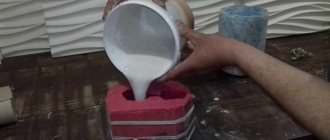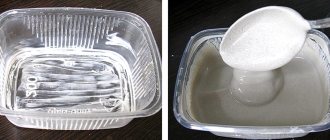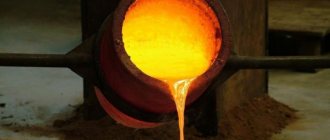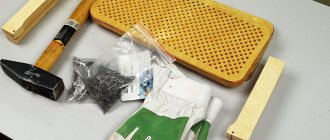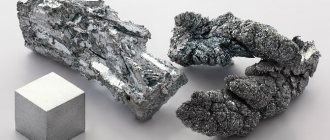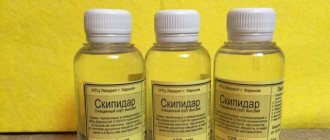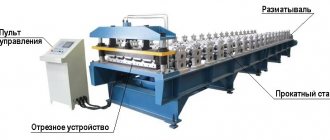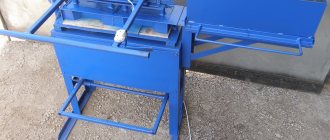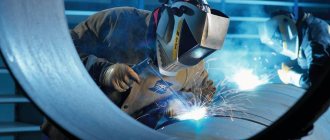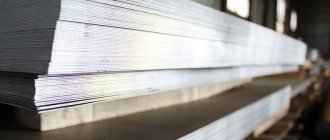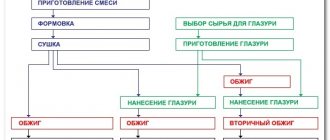Pouring is one of the casting manufacturing operations, the purpose of which is to fill the mold cavity with molten metal. When pouring, as well as during other technological operations, defective castings may occur. An important controlled parameter of the operation is the pouring temperature. “Cold” metal does not fill the mold cavity well and defects are formed in the casting: underfilling, unsoldered joints, and non-slates. At the same time, it may also be difficult for gas bubbles to escape from the casting, which contributes to the formation of gas pockets.
The pouring temperature of a particular casting alloy is determined by its overheating relative to the liquidus temperature. The choice of overheating depends on its effect on the structure and mechanical properties of the alloy, the thickness (minimum, predominant) and length of the casting walls, the tendency of the alloy to form films, the thermophysical properties of the mold material and its initial temperature, the driving force that determines the movement of the alloy in the mold cavity, and other factors. To ensure satisfactory filling of molds when making castings from carbon and low-alloy steels, it is usually sufficient to overheat the melt by 30–60 °C. When producing thin-walled steel castings, overheating is increased to 100 °C. Even greater overheating is prescribed when casting high-alloy steels that are prone to film formation. The absolute values of steel pouring temperatures usually range from 1520 to 1620 °C.
It is possible and advisable to pour cast iron into molds at overheating levels of hundreds of degrees. Depending on the thickness of the casting wall, gray cast iron is cast at 1300–1450 °C. The casting temperature of malleable and high-strength cast iron at the same casting thickness is higher by 30–60 and 50–70 °C, respectively.
Bronze, aluminum and magnesium alloys overheat by 100–200 °C due to film formation. The casting temperature for brass and bronze is 1000–1200 °C, for aluminum and magnesium alloys, 680–770 and 700–800 °C, respectively.
The quality of cast parts also depends on the pouring technique. Therefore, in order to eliminate the possibility of marriage, the following rules must be observed:
- when pouring, the bowl must be filled (“keep the bowl full”), the level of metal in the bowl should be prevented from falling, which can lead to swirling of the melt and entrapment of air into the mold cavity;
- The height of the ladle above the counter fret of the flask should be minimal: for small forms no more than 150 mm, and for large forms no more than 200...250 mm. At high altitudes, the kinetic energy of the metal jet, piercing the mirror in the bowl, will affect the calculated flow rate of the gating system;
- it is necessary to maintain the toe of the bucket in good condition;
- select the capacity of the ladle so that it slightly exceeds the capacity of the mold (or several molds);
- When pouring metal into the mold, make sure that the stream is continuous.
A little history
The most important feature of iron, when it solidifies, to take the form “proposed” to it, was noticed by man back in ancient times. Today, almost all scientists assume that man’s initial acquaintance with metal took place thanks to meteorites. Meteoric iron was fusible and easy to process, so some nascent civilizations had been studying the basics of casting for a very long time.
In our country, metal casting has been a respected and honorable business from time immemorial; people have always treated this craft with great respect. The “Tsar Cannon” and “Tsar Bell” are widely known, being masterpieces of Russian foundry craftsmanship, even if one of them never rang and the other never fired. During the reign of Peter the Great, the Ural foundry workers gained particular fame as suppliers of reliable weapons for the army. However, they rightfully bear this title even now. Before we look at the main types of metal casting, it is necessary to say a few words about the required characteristics of the raw materials.
What type of metal should be used for casting?
The most important property of the metal that is supposed to be used for casting is its fluidity. The alloy in molten form should flow as easily as possible from one crucible to another, while filling its smallest recesses. The higher the fluidity, the thinner the walls can be made of the finished product. It’s much more difficult with metal that doesn’t flow well. Under normal conditions, it manages to set much earlier than it fills all the gaps in the form. It is this complexity that industrialists face when casting metal alloys.
It is not surprising that cast iron became the favorite material of foundries. This is because this alloy has excellent fluidity, making it relatively easy to work with. Steel is far from being so fluid, and therefore to completely fill the mold (so that there are no cavities and voids) you have to resort to a variety of tricks.
In the simplest case, when home-made metal casting is required, the raw materials are melted and poured into water in small portions: this way, in particular, fishing sinkers can be made. But this method is relatively widely used even in the weapons industry! From the top of a special tower, whose outline resembles a cooling tower, molten metal also begins to pour out in measured doses. The height of the structure is such that a perfectly formed droplet, already cooled, reaches the ground. This is how shot is produced in industrial quantities.
Materials used
The “Seven Ancients” is a list of iron, copper, tin, lead, silver, gold and mercury - humanity has been familiar with them for thousands of years. Precious metals were used to make jewelry, and the main material for artistic casting in the past was copper-based alloys. In modern times, cast iron and aluminum were added to them.
Artists throughout history have not limited themselves to the range of materials they can melt. For example, in the 19th century in Europe and Russia, products made of zinc and lead were popular, and modern sculptors often turn to stainless steel. But the classic materials for artistic casting, even today, are bronze and cast iron.
https://youtube.com/watch?v=GHBak_el3CU
Bronze alloys
Alloys of copper with some non-ferrous metals (lead, tin, aluminum, beryllium) without the presence of zinc and nickel are called bronze. Copper with large impurities of zinc is brass. The latter is used mainly for the manufacture of cabinet sculpture and expensive furniture and interior fittings. Tin bronze has remained unchanged for centuries as the main material for artistic casting of large and small forms. Its advantages:
- negligible shrinkage;
- high turnover;
- not susceptible to porosity when cooling;
- high thermal conductivity;
- strength;
- corrosion resistance;
- elasticity;
- weldability.
Bronze casting is one of the oldest arts. Its use in different parts of the ancient world was widespread: people cooked in bronze dishes, wore bronze jewelry, used bronze tools, and fastened their clothes with bronze buttons. This era is known for the amazingly high quality of execution and unprecedented artistic power of sculptures that have survived to this day. Since those times, the bronze foundry tradition began, which has long outlived its century with the same name. Of course, alloys have been improved throughout history, but most of the technological processes of artistic casting have remained unchanged.
Gray cast iron
Bronze and iron are perhaps the most important materials in human history. It is not for nothing that they gave names to two eras of technological evolution - the Bronze and Iron Ages. Since iron casting required higher temperatures and complex furnaces, mankind mastered iron smelting somewhat later than bronze. According to some information, cast iron was poured in China 2 thousand years ago. The first mass products made from it in Europe and Russia were cannon barrels and cannonballs in the 15th century.
The evolution of furnaces and energy-intensive fuels for them quickly made high temperatures accessible not only to the military industry. The artistic use of cast iron began around 1500 with the production of tiles for stoves, monuments and fountains. A powerful impetus for the popularization of cast iron in art was the rapid development of metallurgical technologies in the second half of the nineteenth century and the industrialization that followed these events.
To prepare the sculpture, gray cast iron with a high phosphorus content is used as the most inexpensive alloy of iron and carbon suitable for casting. Phosphorus improves fluidity - this helps the metal to completely fill the mold. The property of phosphorus to increase the fragility of iron for artistic casting is not important, as is the inherent porosity of gray cast iron. The material has another important property - the attractive appearance of the finished product.
"Earth" casting method
The simplest and most ancient method is to cast metal into the ground. But its “simplicity” is a relatively relative concept, since this work requires extremely painstaking preparation. What does it mean?
First, a full-size and maximally detailed model of the future casting is made in the model shop. Moreover, its size should be slightly larger than the product that should be obtained, since the metal will settle during cooling. As a rule, the model is made detachable, from two halves.
Once this is completed, a special molding mixture is prepared. If the future product must have internal cavities and voids, then you will also have to prepare rods, as well as additional molding composition. They must temporarily fill those areas that are “empty” in the finished part. If you are interested in casting metals at home, be sure to remember this circumstance, since otherwise the already filled flask may simply be torn apart by pressure, and the consequences of this may be the most tragic.
Methods used
Traditional technologies have not lost any of their relevance in our time. As a basic technique, craftsmen use casting either in earth molds or using lost wax models. The 19th century saw the height of the rivalry between these two methods. The first became widespread mainly among industrialists, losing leadership in art to more accurate and expensive wax casting.
Casting into the ground
This method combines casting into earth, sand or clay. The main difference between them is the mold material. The essence of the technology is to obtain an imprint from a template on the mixture with a further change in its quality (tamping, adding a binder) and the subsequent formation of a gating system in it - channels through which molten metal will flow in and out.
Advantages of the technology:
- simplicity;
- low cost;
- the ability to create castings of large sizes and masses.
By investment models
This method was popular in Ancient Egypt and China, was used in Greece and Rome, and has not undergone much change over the millennia. The main evolutions occurred in auxiliary materials: craftsmen replaced wax with synthetic mixtures, began to actively use elastic rubber molds, etc. The classic method of melted wax casting looks like this:
- Creation of a wax model by a sculptor - an exact copy of the future casting.
- Making a mold - a paste-like gypsum-clay mixture is applied to the surface of the wax in several stages.
- Baking the mold in the oven. During heating, the wax leaves the mold, flowing through pre-designed channels.
- Pouring molten metal into voids left by wax.
- Freeing the finished sculpture from the clay mold.
- Removing excess metal from a casting, grinding, polishing, artistic chemical treatment.
The lost wax molding method itself allows you to create extremely high-quality and thin products from all types of metals. Technological difficulties can arise only in the manufacture of large elements: such tasks can only be accomplished by highly qualified craftsmen.
What are molding sands made from?
The basis is various types of sands and clays, as well as binding compositions. Their role can be natural and synthetic oils, drying oil, resin, rosin, and even tar.
Next comes the time of molders, whose task is to make casting molds. To explain it more simply, this is done like this: take a wooden box, put half of the mold in it (it’s also detachable), and the spaces between the walls of the model and the mold are clogged with molding compound.
They do the same with the second half and fasten both parts with pins. It is important to note that two special cones are inserted into the part of the mold that will be at the top when pouring. One of them is used to pour in molten metal, the second is used to release expanding gases.
1.2. Calculation of the number of buckets or filling devices
For conveyor production, in addition to the bucket capacity, it is also necessary to calculate the number of buckets or filling devices that must ensure the filling of molds on a continuously moving conveyor.
First of all, the total time τФ spent on pouring one mold is determined using the equation
(2)
where τHALL – mold filling time, s; 60l/vВ – time required to return the ladle to its original position to fill the next mold, s; l – distance between bowls of two shapes, m; vВ – return speed of the cart with the bucket, m/min; τП-З – preparatory and final time (including lowering and raising the bucket during pouring), is taken equal to .. 11, p.
Calculation example. The productivity of the automatic molding line (AML) is 240 molds/hour. To determine the return speed of the cart with the bucket, it is necessary to determine the conveyor speed vк, taking the following assumptions. Let's determine the productivity of APL per minute - 240/60 = 4 forms/min. If the distance l between the bowls of adjacent forms for APL with flasks measuring 700 x 800 mm is taken equal to 1 m, then the conveyor speed will be vK = 4 m/min.
To return the cart with the bucket to its original position, the return speed of the cart vB must exceed the speed of the conveyor vK, i.e. vB = kvк.
If we assume that the coefficient k = 1.5, then vB = 1.5vk = 1.5∙4= 6 m/min.
Let's take τHALL = 15 s, τP-Z = 10 s and use the equation given in the text to determine the time for filling one form, s:
τФ= 15 + 60∙1/6+ 10 = 35.
The line cycle time based on a productivity of 240 forms/hour is τTs = 3600/240 = 15 s. Therefore, to ensure line productivity, the required number of filling buckets (devices) should be τФ/τЦ = 35/15 = 2.33. Rounding this value towards larger numbers, we find that three buckets (or devices) will provide the given AFL performance.
End of the preparatory stage
And now the time comes for perhaps the most important part of the operation. The flasks are separated very carefully, trying not to damage the integrity of the molding sand. After this, two clear and detailed imprints of the future part remain in the ground. After this they are coated with special paint. This is done so that the molten metal does not come into direct contact with the ground of the molding sand. Metal casting technology should not allow this, since otherwise the quality of the finished product may significantly deteriorate.
If there is a need for this, at the same time an additional gating passage is cut, which is necessary for pouring the melt. The flasks are folded again and connected as firmly as possible. Once the molding mixture has dried slightly, you can begin casting.
Start of casting
First, cast iron billets are melted in cupola furnaces, that is, special furnaces. If steel is required to be cast, the raw materials are melted in blast furnaces, open-hearth furnaces, inverter furnaces and other furnaces. To bring non-ferrous metals into a state of melting, specialized melting devices are used.
That's it, you can start casting. If there is only one mold, then the melt is poured into it with a ladle, individually. In other cases, as a rule, a conveyor is organized: either a belt with workpieces goes under the bucket, or the bucket moves over the rows of flasks. Here everything depends solely on the organization of production. When the time comes and the metal has cooled, it is removed from the mold. In principle, this method is ideal in cases where metal casting is required at home (for a forge, for example). It’s still not possible to achieve anything more perfect under such conditions.
Sandblasting or grinding machines are used to remove scale and adhering molding sand from the finished product. By the way, this method was actively used in the production of tanks during the Great Patriotic War. This is exactly how cast turrets were produced, and the simplicity and manufacturability of this process made it possible to produce a huge number of combat vehicles that were so needed by the front. What other types of metal casting are there?
Features of metal casting
Compared to other materials, such as wax or plaster, metal casting differs in several ways. The first of them is the high temperature of transition from solid to liquid state. Wax, plaster and cement harden at room temperature. The melting point of metals is much higher - from 231 °C for tin to 1531 °C for iron. Before you can start casting the metal, it must be melted. And if tin can be melted in a clay bowl on a simple fire made from nearby branches, then to melt copper, not to mention iron, you will need a specially equipped furnace and prepared fuel.
Tin
Lead
For casting more refractory metals, molds made from a mixture of sand and clay will be required. Some metals, such as titanium, require metal molds for casting.
After pouring, the product needs to cool. Reusable dies are disassembled, disposable molds are destroyed, and the casting is ready for further machining or use.
Chill casting
But now they use much more advanced and technological methods for the production of cast products. For example, casting metal into a chill mold. In principle, this method is in many ways similar to the one we described above, since in this case, casting molds are used. Only at the same time they are metal, which greatly simplifies the process of large-scale production.
So, cones and rods are inserted into the two halves (to pour metal and create voids), and then firmly fasten them to each other. That's it, you can start working. The peculiarity of this method is that here the molten metal solidifies extremely quickly, there is the possibility of forced cooling of the molds, and therefore the release process is much faster. With just one die, you can produce hundreds, or even thousands, of castings without spending a lot of time on individual preparation of molds and molding sands.
3D technologies for foundry production: how to create a mold for casting in a week
3D technologies integrated into the foundry process chain provide real benefits to the company. How to show all the benefits of 3D scanning and 3D printing? The most obvious way is to demonstrate the process of creating a part from scratch using additive methods and compare it with traditional technologies. For this purpose, we turned to Pavel Chadushkin, a leading specialist in the production direction of the RP center of iQB Technologies. – So, our task is to create a reference part based on a digital model for subsequent casting of a real product.
Where does this process begin if we use 3D technologies? – First of all, we need the original product, which needs to be scanned and then reverse engineered. Of course, it must be new, not used, so that there is no wear on the part. We evaluate how complex its geometry is and then ask only one question: what should be the accuracy tolerance? Just by its appearance you can understand how this part is produced. Most often this is casting (high-precision or in the ground), milling or manufacturing on a lathe. Each of these production methods has its own tolerances.
Once we have an idea of the production technology and tolerance, we select equipment, namely a 3D scanner with the accuracy parameters we need, and digitize the product. For example, a hand-held scanner Creafrom HandyScan 700 or a stationary Solutionix C500. Such metrological-class devices have already proven themselves well in production enterprises. Once we have a 3D model, we transfer it to Geomagic Design X software, which allows us to quickly and easily process 3D scan data for geometry control and reverse engineering. Then an engineer gets involved in the work, who, based on the scanning results, outlines this part and creates a solid model. During the sketching process, the engineer eliminates various defects of the product from the solid model. It must be emphasized here that absolutely any product has manufacturing deformations. They can be caused by various factors - for example, incorrectly selected material, complex shape, deformation during transportation, worn-out tools used to produce the product.
In any case, no matter what object we take for 3D scanning, it will contain defects and deviations from the standard, and our task is to create this very standard. If the part is round, then we can definitely say that the hole in it will not be round, but elliptical. Accordingly, the engineer, using software, eliminates this ellipse and creates a circle of the correct shape. In this way, by outlining each element of the geometry, we correct all the shortcomings. Once the part is fully outlined, we have a solid that can be put into production.
Casting of a bypass valve for bleeding excess gas pressure (sectional view)
– We received a CAD model. Now you need to determine how to produce the product.
– The traditional method is to prepare equipment for casting wax models on a CNC machine. In this case, the model must be adapted to the machine, with its own tolerances, slopes, roundings - it all depends on the equipment and tools with which the part will be produced.
But now there is a second way - 3D printing, which is an ideal solution for prototyping and small-scale production. The key advantage of additive technologies is the ability to create products of extremely complex shapes (including the smallest details), which cannot be produced using traditional methods. In addition, geometry complexity does not necessarily need to be taken into account when starting a print. This is especially true for the production of products by metal and plastic casting.
If the product has a simple shape, then it is often more expedient to produce it on a CNC machine. If the geometry is complex, then 3D printing is the best option.
When we need not just one working prototype, but a small series - from 10 to 1000 products, we use silicone casting, or two-component casting. To do this, you need to obtain a master model - a standard according to which a silicone mold will be created, into which plastic or wax is then poured.
– We found that 3D printing is an indispensable solution for the production of products using metal and plastic casting. Can you give an example of creating a specific part?
– Let’s take the body of an ordinary telephone made of plastic. Firstly, it is divided into two halves, lower and upper. To produce one of the halves, you need to make a matrix and a punch - this is equipment for plastic injection molding. The metal mold, consisting of two halves, is closed, then plastic is fed into it under pressure, which takes the shape of the internal geometry of the product. In traditional manufacturing, the outer and inner shape of each half is machined using a CNC machine. But if we have a 3D printer, we print the entire finished product at once; there is no need to make metal equipment. Not only will it take a long time to produce, it will be incredibly expensive for a circulation of ten pieces. Thus, the benefit of 3D printing is obvious - there is no need for milling to obtain equipment.
The telephone is a mass-produced product, and we are talking not about ten, but about thousands of products. Just in this case, you need a matrix and a punch, and constant stamping of large quantities. In addition, if you need to make some small change to the design, we can quickly correct the CAD model, immediately print a prototype and check it for assembly, see if we have developed the geometry correctly.
– When creating lost-wax and burn-out master models for casting using a 3D printer, wax and photopolymer are used, respectively (MJP printing technology, QuickCast casting technology). What does the production chain look like using these materials and what are their differences?
– The use of 3D-printed lost wax and burnt-out photopolymer models has the same mechanics, the algorithms of action are slightly different.
We have a printed wax model. We create a crust for it (that is, a mold into which the metal is poured), coating it with fine powder no less than 6-8 mm thick. The type of material and thickness of the crust depends not only on the complexity of the geometry and dimensions of the product, but also on the metal that will be poured into the future form. The part is then placed in the oven. In the oven, the wax is melted, and the crust itself hardens, and we get a solid mold for casting metal.
Wax and photopolymer models of a bypass valve, printed on 3D printers
As for the burned-out photopolymer, we also put the product in the oven, but if the wax is melted at a temperature of +200⁰С degrees, then the photopolymer is melted at +950⁰С. The crust also hardens, and the material from which the model was created burns out.
Next, hot metal is poured into the resulting form - it can be aluminum, titanium, or even magnesium. The mold cools, after which the crust is broken with a hammer or vibrator, and we get a casting.
The next stage is machining. It consists of making the surface of the part smoother - cutting off the sprues on which the metal was poured, grinding them, and removing excess roughness of the product. At this stage, we may also need to drill a hole or adjust fasteners - for this, CNC machines are used to finalize the product to its final version (grinding, sandblasting, drilling, etc.).
– What determines the choice of wax or photopolymer?
– Wax machines are relatively cheap, but the consumables are expensive. With photopolymer 3D printers the situation is the opposite. Compared to photopolymer, wax is a rather fragile material, this is its disadvantage. But 3D wax printing provides the most precise and smoothest surface available today. In addition, wax casting is traditional for all foundries in Russia. Accordingly, photopolymer is suitable where larger models are needed, and strength and detail are less critical. The user must make a choice based on what volumes he will print and how often he will turn to prototyping.
Thus, foundries around the world, including Russia, actively use professional 3D printers from 3D Systems, the world’s leading manufacturer of additive manufacturing plants. At the same time, a number of companies have their own fleet of 3D equipment, while others order 3D printing services from contractors.
– We examined in detail how and in what cases it is beneficial to use 3D printers and 3D scanners. To summarize: why does a foundry need to implement additive technologies?
– To reduce production time when producing prototypes and small-scale parts. We save both time and money.
Let's return to the comparison of the traditional process with the additive one. In the first case it looks like this:
1. The designer develops the part, then transfers his design to the engineer. 2. The engineer adapts it to the production method together with the technologist. 3. Further adaptation consists of creating a drawing of the future shape of the matrix and punch or a drawing according to which the part will be turned on a milling machine. 4. Then the matrix and punch are made on the machine and sent for production.
So, from the moment the designer issues the finished project to the engineer until he receives the mold into which the product will be cast, it takes from six months to a year. And let's say six months passed, we made ten prototypes, gave them to the designer, he tried on these metal blanks, but they did not match the seats. He understands why they do not match, refines this model, and then the cycle repeats. At least another six months pass before the next fitting.
With the help of a 3D printer, the designer actually sends his product for printing by pressing one button and sends it directly to production for casting. The period is reduced from a year or six months to a maximum of a week. This is the most important advantage. Plus, we save significant money on mold manufacturing. And finally, we have the ability to create products with geometries of any complexity and, if necessary, quickly optimize the design in software.
Some disadvantages of the method
The disadvantage of this casting method is the fact that only those types of metals that are characterized by increased fluidity in molten form are suitable for it. For example, only injection molding is suitable for steel (more on this below), since this material does not have good fluidity at all. Under the influence of compressed air, even the most “ductile” steel grades take the required shape much better. The bad thing is that an ordinary mold simply won’t withstand such extreme production conditions and will fall apart. Therefore, we have to use a special production method, which we will discuss below.
Advantages and disadvantages of centrifugal casting
Using centrifugal casting, it is possible to obtain a casting with a geometrically correct free surface only if the rotation speed is strictly defined (it is determined by such an indicator as the gravitational coefficient). If the rotational speed of the casting is insufficient, then due to shrinkage, both in the vertical and horizontal position of the axis, distortions inevitably occur.
Thus, it can be stated that one of the advantages of centrifugal casting is that it can significantly improve the fillability of the mold with the melt, since it is subject to increased pressure arising under the influence of centrifugal forces. In addition, fewer shells, pores, and various inclusions are formed in castings, and their density increases significantly.
It should also be noted that the advantage of this casting method is also a reduction in metal consumption and an increase in such an indicator as the yield, due to the absence of a gating system. In addition, when centrifugally casting parts and workpieces in the form of pipes and bushings, there is no need to incur costs for technological rods.
As for the disadvantages, centrifugal casting also has them. These include the difficulty of making castings from those alloys that are prone to segregation; inaccuracy in the dimensions of the cavity of castings having free surfaces; increased contamination of casting surfaces with liquids and non-metallic inclusions (because of this, it is necessary to significantly increase the allowances for their mechanical processing).
Injection molding
How is metal injection molded? We have already discussed some aspects above, but it is still necessary to discuss this issue in a little more detail. Everything is quite simple. Firstly, you need a casting mold made of high-quality steel, which can be multi-stage, with a complex internal shape. Secondly, you need injection equipment capable of delivering from seven to seven hundred MP.
The main advantage of this smelting method is high productivity. What else does injection molding provide? In this case, much less metal is used, and the surface quality of the finished product is very good. The latter circumstance involves abandoning the complex and rather tedious procedure of cleaning and polishing. With this production method, what materials are most preferable to produce finished products and parts from?
The most commonly used alloys are based on aluminum, zinc, copper and tin-lead (non-ferrous metal casting). Their melting point is relatively low, and therefore very high manufacturability of the entire process is achieved. In addition, this raw material has a relatively small sediment upon cooling. This means that parts can be produced with very tight tolerances, which is extremely important in modern technology.
The complexity of this method is that when separating finished products from molds, they may be damaged. In addition, this method is only suitable for the manufacture of parts with relatively small wall thickness. The fact is that a thick layer of metal will harden extremely unevenly, which will predetermine the formation of cavities and cavities.
Features of the formation of castings and their quality
When injection molding, the main indicators of casting quality - dimensional accuracy, surface roughness, mechanical properties, density and tightness - are determined by the following features of its formation:
1
. The short duration of filling the mold cavity with the melt. The rate at which the melt enters the mold for different castings and alloys ranges from 0.3 to 140 m/s, the duration of its filling is 0.02 - 0.3 s, and the final pressure on the melt can reach 500 MPa. This allows, despite the high cooling rate of the melt in the mold, to produce very complex body castings with a wall thickness of less than 1 mm from alloys with low and even close to zero fluidity (this property is possessed, for example, by alloys in the solid-liquid state). The high kinetic energy of the moving melt and the pressure transferred to it at the moment of completion of filling the mold contribute to the production of castings with low surface roughness.
2
. Gas-tightness of the mold material. Ventilation of the working cavity occurs through special ventilation ducts. At high rates of melt entry into the mold cavity, air, as well as gaseous decomposition products of the lubricant formed during its interaction with the melt, do not have time to completely remove from the mold during its filling with the melt. They prevent the mold from filling and enter the melt, leading to the formation of non-sheets, non-welds, cavities and gas-air porosity in the castings. Gas-air porosity leads to a decrease in the density of castings, a decrease in their tightness and plastic properties. Air, gases, and lubricant decomposition products located in the pores of the casting under high pressure complicate its heat treatment: when heated, the strength of the casting decreases and the gas pressure in the pores increases, which causes warping of the casting and bubbles appear on its surface.
To reduce gas-air porosity in castings, a number of technological methods are used, as well as special injection molding methods (see subsection 4.2).
3
. High intensity of thermal interaction between the casting material and the mold, due to its high thermal conductivity and heat capacity, low thermal resistance of the lubricant layer and its decomposition products, significant pressure of the melt and casting on the walls of the mold, improving the contact between them. This helps to obtain a fine-grained structure, especially in the surface layers of the casting, increasing its strength and high process productivity.
4
. At the moment of completion of filling the mold with metal, the pressure developed by the press piston in the pressing chamber is transferred to the melt in the mold cavity. This improves the nutrition of the casting, helps reduce shrinkage porosity, and compress gas-air inclusions. As a result, the density, tightness and mechanical properties of the casting increase. However, the effectiveness of pre-pressing is limited, since this pressure on the melt in the mold acts only until the feeder hardens.
5
. Using a metal mold with precise dimensions and low roughness of working surfaces. This facilitates the production of high-precision castings in terms of weight, geometry and dimensions. High dimensional accuracy of castings (classes 1 - 4 according to GOST 26645-85 (amendment No. 1,1998)) allows you to reduce machining allowances to 0.3 - 0.8 mm, and in some cases completely eliminate cutting processing. All that remains is to clean the places where the feeders, connecting channels of the washers and flash are removed. The mass accuracy coefficient of castings (MCM) during injection molding reaches 0.95 – 0.98. The surface roughness of injection moldings depends mainly on the surface roughness of the mold and the casting technological conditions. Typically, these castings have a roughness from Rz = 160 – 80 µm (copper-based alloys) to Rz = 1.00 – 0.32 µm (zinc alloys).
Types of installations for "spinning" casting
All machines that are used in this method of casting metal products are divided into two large groups: with a hot and cold casting chamber. The "hot" variety can most often only be used for zinc-based alloys. In this case, the casting chamber itself is immersed in hot metal. Under the pressure of air or a special piston, it flows into the casting cavity.
As a rule, a strong injection force is not required; pressure up to 35-70 MPa is enough. So, in this case, molds for metal casting can be much simpler and cheaper, which has the most favorable effect on the final cost of the product. In cold casting molds, the molten metal has to be “driven” deep into the casting chamber under particularly high pressure. Moreover, it can reach 700 MPa.
Lost wax casting
As in the very first case we considered, from ancient times mankind knew about the method of pouring molten metal into a previously prepared model made of paraffin or wax. It is simply placed in the flask and the gaps are filled with molding sand. The melt dissolves the wax and ideally fills the entire volume of the primary workpiece. This method is good because the model does not need to be removed from the flask. In addition, it is possible to obtain parts of simply ideal quality; this metal casting process is relatively easy to automate.
1.1. Bucket capacity calculation
The mass of metal in the ladle is determined by the total metal consumption of the molds poured from one ladle, taking into account the reserve to compensate for possible overflows and forming errors (3... 5% of the ladle volume).
For mass production, the mass of metal is determined experimentally in order to reduce waste and prevent underfilling of molds. The capacity of the ladle filled with metal GК, kg, is calculated according to the equation
, (1)
where ΔtTU – permissible pouring temperature range according to TU, °C; Δti – temperature decrease when pouring one mold, °C; = metal consumption of the mold, kg.
Calculation example . Let us assume that ΔtTU = 1400 – 1340 °C = 60 °C, and the temperature decrease when pouring a mold with metal content = 50 kg is 20 °C. Then, according to the above equation, the bucket capacity will be GК = (60/20) • 50 = 150 kg. This value must be increased by 5% to compensate for splashes and metal spills. We will finally get 157.5 kg.
The calculated bucket capacity (157.5 kg) is the maximum allowable. The actual capacity of the ladle is chosen to be slightly smaller than calculated, taking into account possible interruptions in pouring and the time of turning the ladle, especially when pouring the last doses.
Shell casting
If the casting is relatively simple, and “cosmic” strength is not required from the finished product, the method of casting into shell molds can be used. They have been made since time immemorial, using fine quartz sand and resin as the base. Today, naturally, various synthetic compounds are used as the latter.
Then dismountable metal models, consisting of two halves, are taken and placed on a surface heated to approximately 300 degrees Celsius. Then the molding mixture (from sand and dry resin) is poured there so that it completely covers the surface of the metal models. Under the influence of heat, the resin melts, and a fairly strong “molding flask” appears in the thickness of the sand.
As soon as it all cools down slightly, the metal pigs can be removed, and the sand can be sent to the oven for “roasting”. After this, fairly strong forms are obtained: by connecting their two halves, you can pour molten metal into them. What other metal casting methods are there?
Types of molding
They are determined by the type of model and the chosen casting method.
According to a simple model
The model is placed face up on the board. Center it relative to the flask. Cover with a facing mixture, then add filler in layers, carefully compacting each layer. Add soil to the flask until it is filled. Having removed the upper flask, take out the model and create a gating system. The flasks are collected together, secured and dried.
According to split model
The method significantly simplifies the technology and increases the accuracy of manufacturing the casting mold. A part of the model without spikes is placed on the board, the lower flask is installed and the ground is shaped. Upon completion, the structure is turned over, the second part is attached to the model, the upper flask is attached and it is stuffed.
With false cover
For particularly complex product geometry, I use false pins. It does not come into contact with the melt, but plays the role of a figured fake board.
Forming methods
Lumpy
It is used for artistic casting, especially sculptural compositions. The model is furnished with several independent flasks, their edges touching. Sometimes a casting is divided into segments that are relatively simple in configuration, they are modeled and cast independently, and then the finished castings are connected.
Template
It is produced by casting products of a certain shape into the ground. Distinguish
- Bodies of rotation (cylindrical, conical and elliptical)
- Rectangular or prismatic.
The formation of the earth is carried out by a template of the appropriate configuration, driven by a powerful spindle for bodies of rotation or moving along special guides for prismatic shapes.
Centrifugal casting
In this case, the melt is poured into a special mold, which rotates at a very high speed in a horizontal or vertical projection. As a result of the action of powerful equally applied centrifugal forces, the metal flows evenly into all spaces of the mold, thereby achieving high quality of the finished product. This casting method is ideal for producing various types of pipes. It allows you to mold a much more uniform wall thickness, which is extremely difficult to achieve using “static” methods.
Electroslag casting
Are there any methods of metal casting that can rightfully be called modern? Electroslag casting. In this case, liquid metal is first obtained by exposing previously prepared raw materials to powerful electric arc discharges. The arcless method can also be used, when the iron melts from the heat accumulated by the slag. But the latter is affected by powerful discharges.
After this, the liquid metal, which has never come into contact with air throughout the entire process, enters the crystallization chamber, which also doubles as a casting mold. This method is used for relatively simple and mass castings, for the production of which many conditions do not need to be met.
Vacuum filling
It is used only in the case of “elite” materials, such as gold, titanium, high-quality steel. In this case, the metal is melted under vacuum conditions, and then quickly (under the same conditions) distributed into molds. The good thing about this method is that when it is used, the formation of air cavities and cavities in the product is practically eliminated, since the amount of gases present there is minimal. It is important to remember that the weight of the castings in this case cannot exceed hundreds or two kilograms.
Is it possible to obtain parts of greater weight?
Yes, such technology exists. But it can only be used in cases where one hundred tons of steel or more are simultaneously processed. First, the metal is melted under vacuum conditions, and then it is poured not into molds, but into special molding ladles, which are also protected from air entering their cavity.
After this, the finished melt can be distributed into molds, from which the air has also been previously pumped out with a pump. The steel obtained as a result of this technological process is quite expensive. It is used for forging, as well as some types of casting, when it is required to obtain blanks and parts of the highest possible quality.
Casting using gasified (burnt out) models
In terms of casting quality and simplicity, this method is one of the most profitable, and therefore it is used more and more widely in modern industry. This type of metal casting, the production of which is increasing year by year, is especially popular in China and the USA, since the industrial bases of these two countries have the greatest need for high-quality steel. The advantage of this method is that it allows the production of castings without any restrictions on weight and size.
In many ways, this method is similar to those described above: for example, in this case, the primary model is used not from wax or plasticine, but from the now widespread foam plastic. Since this material has its own specifics, the binding sand mixture is filled into the flask under a pressure of approximately 50 kPa. Most often, this method is practiced in cases where it is necessary to make parts weighing from 100 grams to two tons.
However, we have already said that there are no strict restrictions on the size of parts. Thus, using this casting method, even components for ship engines, which have never had “modest” dimensions, can be produced. For each ton of metal raw materials, the following amount of additional materials is consumed:
- Fine quartz sand - 50 kg.
- Special non-stick coating - 25 kg.
- Granulated polystyrene foam - 6 kg.
- Thick polyethylene film - 10 sq. m.
The entire molding mixture is pure quartz sand without any additional additives or additives. It can be approximately 95-97% reused, which significantly increases efficiency and reduces the cost of the process.
Thus, metal casting (the physics of the process was partially considered by us) is a “multifaceted” phenomenon, since today there are a lot of new techniques. In parallel, modern industry uses methods that were in use several thousand years ago, slightly adapting them to current realities.
